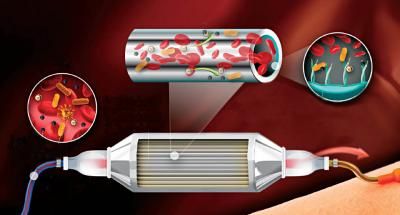New technology to treat sepsis, a global killer
The National Science Foundation has just awarded $200,000 to engineers at Oregon State University who have developed a new technology that they believe could revolutionize the treatment and prevention of sepsis.

In this graphic image of a device used to prevent sepsis, coatings inside microchannels help remove bacterial fragments and endotoxins in blood as it flows through.
Graphic by Christina Ullman, courtesy of Oregon State University
More commonly called "blood poisoning," sepsis can quickly turn a modest infection into a whole-body inflammation, based on a dysfunctional immune response to endotoxins that are released from the cell walls of bacteria. When severe, this can lead to multiple organ failure and death.
When treatment is begun early enough, sepsis can sometimes be successfully treated with antibiotics. But they are not always effective and the mortality rate for the condition is still 28-50 percent. About one in every four people in a hospital emergency room is there because of sepsis, and millions of people die from it around the world every year, according to reports in the New England Journal of Medicine and other studies.
In pioneering research, OSU experts have used microchannel technology and special coatings to create a small device through which blood could be processed, removing the problematic endotoxins and preventing sepsis. Several recent professional publications have reported on their progress.
"More work remains to be done, and the support from the National Science Foundation will be instrumental in that," said Adam Higgins, principal investigator on the grant and an assistant professor in the OSU School of Chemical, Biological and Environmental Engineering. "When complete, we believe this technology will treat sepsis effectively at low cost, or even prevent it when used as a prophylactic treatment."
This technology may finally offer a way to tackle sepsis other than antibiotics, the researchers said.
Most read news
Other news from the department research and development

Get the life science industry in your inbox
By submitting this form you agree that LUMITOS AG will send you the newsletter(s) selected above by email. Your data will not be passed on to third parties. Your data will be stored and processed in accordance with our data protection regulations. LUMITOS may contact you by email for the purpose of advertising or market and opinion surveys. You can revoke your consent at any time without giving reasons to LUMITOS AG, Ernst-Augustin-Str. 2, 12489 Berlin, Germany or by e-mail at revoke@lumitos.com with effect for the future. In addition, each email contains a link to unsubscribe from the corresponding newsletter.




















































